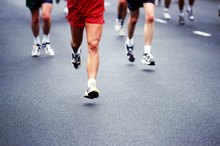Stretching & Contraindications for Hip Replacement
Total hip replacement is one of the most common surgical procedures performed. According to the American Association of Orthopedic Surgeons, 193,000 procedures are done annually. The primary goal of the surgery is to decrease or eliminate pain so that you can get on with living your life. You can enhance your recovery process and eliminate your apprehension of potential injury by exercising properly. Knowing what to do and what to avoid will ease your mind and reduce your risk of falls.
Considerations
You may have a total or partial hip replacement or a posterior lateral, anterior lateral, or anterior approach. Your specific surgical procedure will dictate specific exercises and contraindications after surgery. Your surgeon will also have her own instructions for you. Consider the following as guidelines for understanding what to expect. If you have posterior lateral surgery avoid hip flexion greater than 90 degrees; hip adduction past the mid line of the body; and hip internal rotation past neutral. If you habitually cross your legs you'll have to avoid it post-surgery. If your surgeon performs the anterior lateral approach you want to avoid the same aforementioned exercises in addition to hip external rotation and flexion. The anterior approach has the least restrictions and those include hyperextension of the hip and extreme hip external rotation -- in other words, positions where you turn your toe inward toward the center of your body. Your restrictions will last from eight weeks up to one year after surgery.
Function
Exercises to Increase Hip Size
Learn More
Resume normal activities of daily living within three to six weeks of surgery, suggests the American Academy of Orthopedic Surgeons. Perform your usual sitting, standing and walking up and down stairs in addition to specific exercises that restore range of motion and strengthen your hip. These will be provided to you in the hospital and you may be referred to a physical therapist for further assistance. Use a pillow between your legs to sleep until your doctor tells you otherwise. High impact activities should be avoided as should any activities where there is high risk of falling. Progress your activity level gradually to increase strength and mobility without undue stress to your new joint.
Features
Restore strength and endurance around your hip and core. Open-chain exercises are often used in the early stages of rehabilitation. Two open-chain exercises follow that require lying on either the floor or a solid elevated surface. If you don't have access to a stretching table, don't overlook the fact that getting up and down from the floor is a complicated move. Practice during physical therapy sessions or with a trainer to be sure you're following postoperative guidelines.
Start with side lying leg lifts. Lying on your side with your new hip on top and your top hand on the floor in front of you to support you. Keep your knee and toe pointed straight ahead. Pillow your head and neck with your bottom arm. Lift and lower your top leg 15 to 20 times as tolerated. Repeat on the other leg in order to maintain a balance.
Next perform a bridge exercise. Lie on your back, knees bent, feet flat on the floor. Press the hips toward the ceiling. Hold for a count of three and slowly lower down. Repeat 15 to 20 times. When you're able to perform 20 repetitions of both exercises, add a second set. You can perform these exercises most days. When these become easy, progress to more functional exercises that will challenge you further.
Progression
How to Strengthen the Patella Tendon
Learn More
Gain strength to enhance balance and enable you to increase your total activity. Begin with exercises that mimic daily living such as a sit to stand exercise. Rise and lower to a chair in sets of 15 to 20 repetitions. Practice rolling over in bed and entering and exiting a car. Expect some discomfort as your hip heals and you begin using deconditioned muscles again. Cardiovascular exercise is also important. It will increase your endurance and stamina and continue to build mobility and strength in the new joint. Walking is very appropriate. Water exercise increases resistance and safely challenges balance. Once your wound is healed seek a pool if you enjoy water exercise or are nervous about falling while you exercise. You can also use an elliptical trainer or a stationary bicycle to reduce the load on your new joint. Cardiovascular exercise is an important part of your recovery process once you've regained initial function strength.
Challenges
Stretching will reduce tension in tight areas of the hip. Stretching while heeding your post-operative guidelines will be a challenge, however. Perform standing stretches such as a lunge using a wall for support. Stand facing the wall, with one foot forward and one foot back. Bending the front knee, keep the rear knee straight. Stretch the rear of the leg by sitting in a chair and use a long towel to reach around your foot to avoid deep flexion at the hip. For example, sit toward the edge of a chair with one leg extended with the towel around the arch of your foot while you have the other foot flat on the floor for support. Holding the ends of the towel sit straight and gradually increase the tension on the towel as you lean slightly forward. Don't go beyond 90 degrees flexion at the hip. Stretch to a point of mild tension.
Warning
Minimize your risk of falls. Exercise under supervision when you're trying something new. Your progression will be unique to you. Tying your shoes can continue to be a challenge even though you are able to progressing to with hip strengtheners and cardiovascular exercise. Proceed with caution during the first year when your hip is most vulnerable so that you avoid falls. Avoid excessive stretching, yoga poses, and jarring forces to the hip.
Related Articles
References
- American Academy of Orthopedic Surgeons: Total Hip Replacement
- "ACE Advanced Health & Fitness Specialist Manual"; Cedric Bryant, PhD. and Daniel Green; 2009
Writer Bio
Experienced radio show co-host, author, and professional speaker Debra Atkinson, MS, CSCS is the Voice for Fitness. With more than twenty-five years experience in the fitness industry she specializes in the business of personal training and helping develop thriving environments that clients, owners and trainers all find rewarding.www.voiceforfitness.com








